The latest on materials and procedures
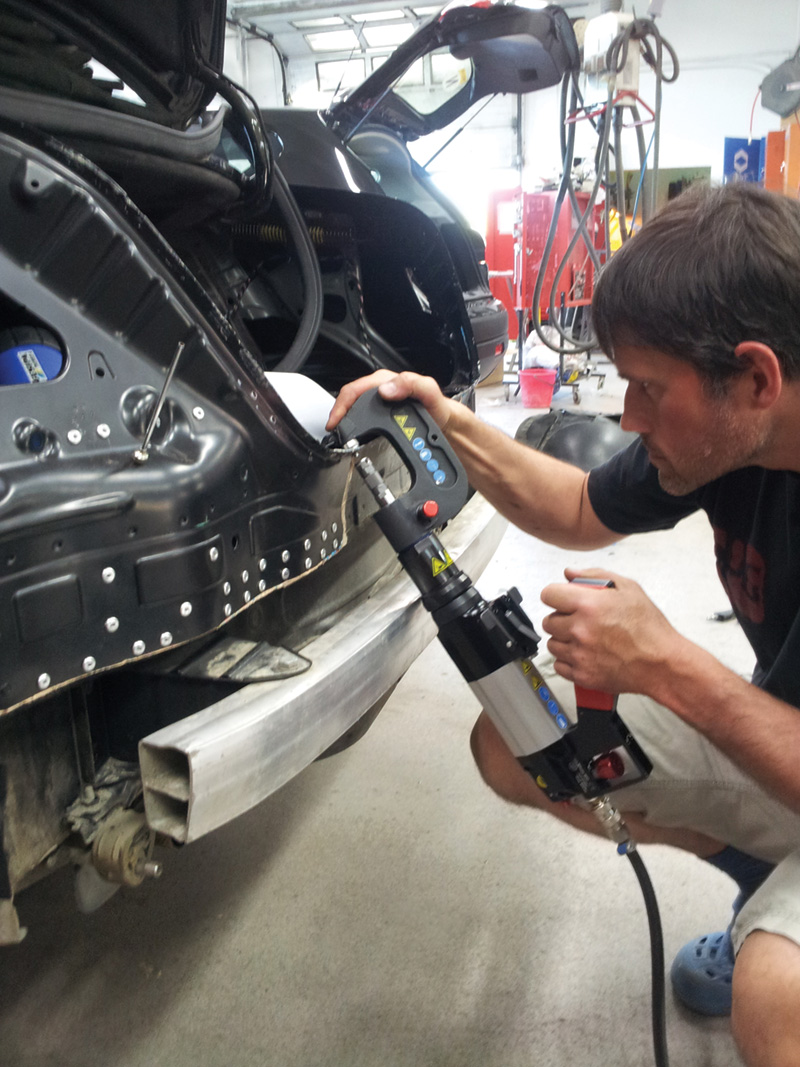
New riveting and adhesive bonding techniques and tools give technicians a faster and more effective way to repair advanced high-strength steels, aluminum, and other materials.
In an ongoing quest for fuel economy improvements, Mercedes-Benz vehicles have shed weight by replacing traditional steel with high- and ultra-high strength steel combined with aluminum, magnesium, composites and other lightweight advanced materials. These hybrid structural and non-structural components provide the same or greater strength while being thinner and lower in weight. The lightweighting benefits come with requirements for new joining methods.
Traditional welding does not work when joining dissimilar materials, due in part to their different melting points. Standard pop rivet technology will not work when combining high- and ultra-high strength steels with aluminum and other softer materials. These softer materials can easily become deformed by the force required to punch through the significantly higher strength and stiffness of high- and ultra-high strength steels.
The thermal and mechanical joining methods we’re used to have had to be updated to work with advanced materials and new multi-material, or hybrid, joints.
Glue is glue, yes? No!
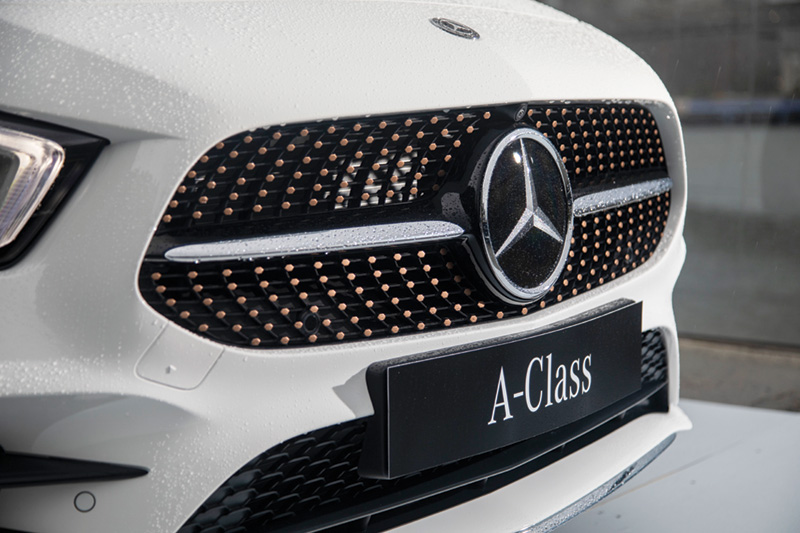
Structural adhesives, rivets, and other fasteners used on Mercedes-Benz vehicles are the result of technological advances and are application-specific. Mercedes-Benz only allows the use of adhesives that are specified in official published repair documents, and only Genuine Mercedes-Benz replacement rivets and other fasteners. ALWAYS refer to WIS.
Even for joints that can be bonded using adhesive alone, we now have different products for specific applications. Some adhesive formulas emphasize elasticity, others stiffness and strength. Some may cure at room temperature, while others require heat.
Structural versus panel bonding adhesive
Adhesives were primarily used in repair of non-structural panels until recently. Panel bonding adhesives were not designed to meet the requirements of joining structural parts.
Joining structural components requires greater peel strength, impact strength, and lap shear strength than a panel bonding adhesive offers. To slow the deformation of structural components during a collision, adhesives must also absorb more collision energy. This adds a requirement for increased flexibility properties in the bonded joint.
New impact-resistant structural adhesive (IRSA) products are formulated to offer both strength and elasticity. They are specified to add a “bend, but don’t break†(up to a point) capability, especially to structural components that help protect the passenger compartment. In addition to absorbing more energy, impact-resistant structural adhesives offer better high- and low-temperature performance, corrosion protection, and resistance to residual stress.
Impact-resistant adhesive is often recommended for joining thin panels. The flexibility properties help the joint absorb impact force in a collision, where adding fractions of a second longer for a joint to reach its breaking point may make a huge difference in the ultimate safety of the vehicle. When impact-resistant adhesive is specified, it is absolutely critical to the future reliability of that repair. Never substitute a panel bonding adhesive where an IRSA product is specified.
Refer to your Mercedes-Benz repair information first for adhesive requirements recommendations. Remember that structural repairs have safety consequences. When it comes to adhesives, there is always an approved Mercedes-Benz version. If there is another option, it would also be called out in WIS.
Adhesive science and performance
Adhesives used in structural bonding fall into either the thermosetting, thermoplastic, or elastomeric category. Modern adhesives are often hybrid combinations of thermosetting with either thermoplastic or elastomeric formulations, depending upon which strength, stiffness, temperature resistance, elasticity, and other performance characteristics are desired.
Thermosetting adhesives are synthetic or organic substances that are converted by molecular cross-linking into a permanently hard, solid state. The molecular cross-linking may be initiated by heat, chemical catalysts, or a combination of both. Thermoset adhesives have a higher modulus of elasticity (ability to absorb a higher amount of stress without permanently deforming) and greater resistance to heat and chemicals, but lower toughness than thermoplastics or elastomerics. Many thermosetting adhesives feature an epoxy-based formulation.
Thermoplastic adhesives are synthetic or organic substances that harden when cool and soften when heated. They may not be suitable for structural applications, unless specifically designed to have high strength and durability under elevated temperatures. Examples of common thermoplastics include polyvinyls, polyacrylics, and polyethylene.
Elastomeric adhesives are organic substances that after being stretched a great deal can return to their original shape and strength. They are frequently specified for use as sealants. They are also often included as a modifier in thermosetting or thermoplastic adhesive formulas to improve toughness and peel strength for structural applications. Common elastomerics include silicone, polyurethane, nitriles, and other natural and synthetic rubber compounds.
In addition to the basic resin, an adhesive may contain solvents, fillers, catalysts, dilutents, hardeners, antioxidants, and plasticizers. These may be added to adjust viscosity, temperature resistance, strength reinforcement, and other performance properties, or to activate and control the pace of the curing process.
The increased variety of adhesive types and properties means that you must check the Mercedes-Benz repair information to determine the correct product for your repair application. The risk of using just any crash-durable adhesive is that you don’t know what may be different enough about the application to reduce that brand’s effectiveness in a Merecedes-Benz vehicle. You have no way of knowing if another adhesive is “equivalent.†Mercedes-Benz engineers have tested and validated the adhesive specified for a given repair. By putting its name or endorsement on an adhesive, Mercedes-Benz is providing a shorthand answer to the question of what performance standards that product meets.
Variety is the spice of…
Dissimilar metals that are being used because they offer strength at lighter weight may have problems with heat, galvanic reaction (corrosion), and kinetic (high impact) joining methods. Traditional joining techniques such as welding and riveting may not be applicable to creating or rebuilding joints in which one or more of the substrates cannot tolerate heat, or is too thin for the kinetic force developed in the spot welding or riveting process.
Adhesives help solve some of the issues associated with joining these finicky materials. For example, adhesives placed between dissimilar metals such as aluminum and steel or magnesium and steel provide a buffer that prevents formation of galvanic corrosion.
Steel, aluminum, magnesium, carbon fiber, and other composites each have different coefficients of linear expansion, which is just a fancy way of saying they expand and contract at different rates. The right adhesive can allow dissimilar materials to expand and contract at different rates without weakening the joint bond. Adhesives also help reduce transmission of vibration-related and kinetic noise through to adjacent panels.
The type and amount of adhesive, and whether it is combined with riveting, welding, or used alone is a function of the required joint strength and stiffness or flexibility, the size of the gap, the expansion and curing properties of the adhesive, and other factors. This may be background information that is not included in service manuals, but you can bet that Mercedes-Benz engineers have done a lot of research to develop the correct repair procedure recommendations for you.
Follow Workshop Information System instructions for prepping the mating surfaces of panels to be joined. How the surfaces must be cleaned, whether they are to be perfectly smooth or slightly textured, the temperature of the adhesive and the surfaces, and how quickly you must work after mixing a two-part adhesive or after opening a product are just a few of the factors that, done correctly, provide good adhesion.
If your repair information includes surface preparation steps that are not listed on the adhesive instruction sheet or label, make sure to follow the Mercedes-Benz instructions. The Mercedes-Benz repair instructions may have been updated with information that, due to running model changes, was not available at the time the adhesive label was printed.
Hybrid joining
Mercedes-Benz requires structural adhesives in combination with riveting or spot welding for many repairs. This is called cold joining because it avoids or minimizes the use of heat. The resulting joint is referred to as a hybrid because it combines the strengths of an adhesive and a fastener (rivet or spot weld) to compensate for the individual weaknesses of each method.
Adhesives resist shear forces better than rivets to the extent that they spread any collision force over a wider area of the impacted joint. Mercedes-Benz engineers design structural joint geometry to minimize the likelihood of the joint being sheared apart during a collision. In an abundance of caution, they add rivets, flow drill screws (FDS), spot welds, or other mechanical fasteners to further reinforce many joints against the unlikely event of peel failure. Mechanical fasteners also contribute instant fixturing, so you can continue to work on or around the joint without waiting for adhesive to cure.
Mechanical fasteners better resist pull-out or peel failure; however these types of fasteners have only a small footprint to handle any impact forces. Adding adhesive distributes the stress load over a larger area, increasing overall joint strength. With hybrid joints, two is better than one.
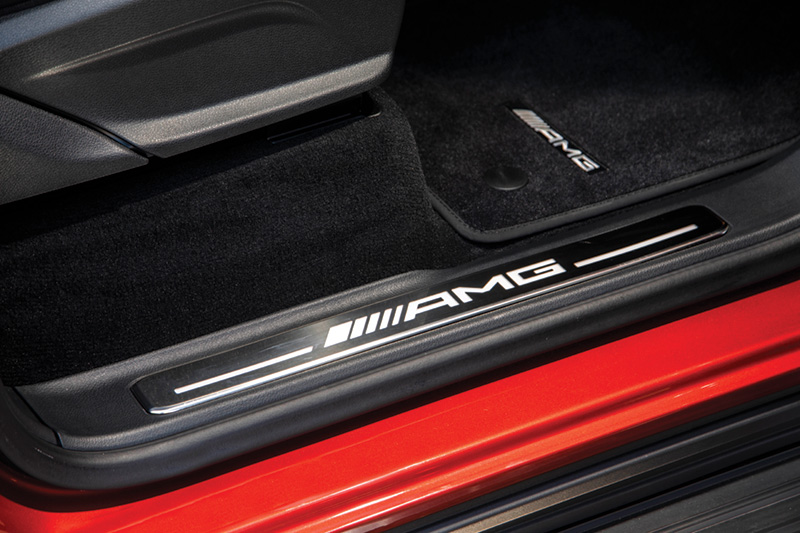
Rocker panels, frame rails, floor pans, and other structural components are joined by hybrid adhesive and mechanical fastening technologies on many Mercedes-Benz models.
Tip: Do not attempt to substitute an IRSA as an adhesive-only repair where a hybrid (combination adhesive and mechanical bonding) joint is required. If a hybrid joint is required, assume that the joint geometry demands both the extra peel strength offered by a mechanical fastener and the enhanced shear strength of an adhesive. And don’t forget to check to make sure the expiration date on the adhesive label has not already passed.
Bolts, flow drill screws, clinching, and riveting are all mechanical methods used with or without adhesives to build and repair vehicles that combine aluminum with steel and other metallic or non-metallic materials.
Vehicle structural components joined by hybrid adhesive and mechanical fastening can include structural parts such as frame rails, rocker panels, strut towers, floor pans, wheel houses, and other areas.
Rivet bonding
Combining rivets and adhesive is a quick and effective method of creating a durable joint between dissimilar materials. Rivet bonding eliminates welding heat as a source of weakening of the metal being joined. Additionally, rivets fit tightly to the joint, creating a seal that, in combination with adhesive acting as a barrier between any dissimilar metals, creates a corrosion-resistant joint.
The new skills a technician must learn are straightforward, but critical to a successful repair. They include how to use the rivet gun, how to select the correct rivet for the application, and which adhesive formulation is appropriate for the repair. Your Mercedes-Benz repair information will tell you the requirements a rivet gun must meet, what rivet is required for a given application, and which adhesive to use.
Riveting story
Pop rivets are pulled by the tool through a pre-drilled hole in the material stack. Pulling the metal shank compresses and breaks the rivet flush with its head. Pop rivets can be used in structural and non-structural applications. They are also known as pull-style or blind rivets. A blind rivet is necessary if there is access to only one side of the joint, or if there is a pre-drilled or pre-punched hole all the way through the material stack.
A self-piercing rivet (SPR) presses the layers together and flares out to form an interlock on the inside of the joint. A die under the bottom panel guides the flaring of the rivet to create a mechanical interlock. Some Mercedes-Benz dies are application-specific. In high-strength advanced steels, selection of the correct rivet and die is critical to the ability to flare out the rivet without causing the lower substrate to crack.
An SPR should pierce the top, or thinner layer of material and flare in the lower (and typically thicker) layer, without punching all the way through. If your rivet pierces the bottom layer of the material stack, something is wrong. Either you have a rivet that is too long for the application, or your tool pressure setting is incorrect. Selecting the proper rivet part number and installation procedure is critical to creation of a durable joint. SPRs offer lower risk of fatigue failure than spot welding, and SPRs can be used on aluminum, steel, plastics, and other materials.
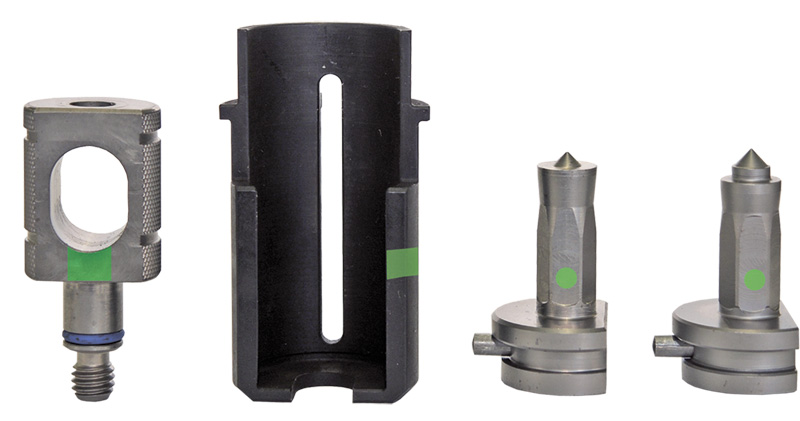
A clinch rivet is similar to an SPR, except nothing pierces through either the top or bottom layer of the material stack. A solid clinch rivet instead presses all layers down against a die under the bottom layer. As the clinch rivet presses down and flares out, it forces all layers of the material stack to flare out in the same bucktail pattern. Flaring all layers simultaneously adds strength without punching through thinner metals. Work hardening occurs in the top layer as it is pressed around the rivet. This increases the tensile and lap shear strength in the joint area of the otherwise thin top layer.
Flow-form rivets (FFRs) are installed in a pre-punched hole to which adhesive is applied, then the rivet is inserted and pressed to pull the layers of the material stack together.
Most rivet installations also include adhesive in the space between rivets. The increased surface area being bonded helps strengthen the joint significantly versus riveting alone. Applying the correct adhesive with the factory-recommended line thickness ensures creation of the desired strength bond.
Although the rivets can be installed through adhesive, there are still differences in the process, depending on which type of rivet you are using. For pop (pull-type) rivets, drill and deburr the holes, apply adhesive and join the substrates before installing the rivet. The process is similar for SPRs, except no pre-drilling of holes is necessary. With flow-form (FFR) rivets, you punch holes after the panels have been joined, then deburr the holes and install the rivets.
Gun control
The proper tool must be used to install each type of rivet. Use of an incorrect tool could deliver either too much force, causing distortion in the workpiece, or not enough clamping force to successfully position and hold the rivet. For example, SPR extraction or insertion in aluminum or thin high-strength metals requires a gun that combines extremely high compression force with precise control over angle and depth of impact.
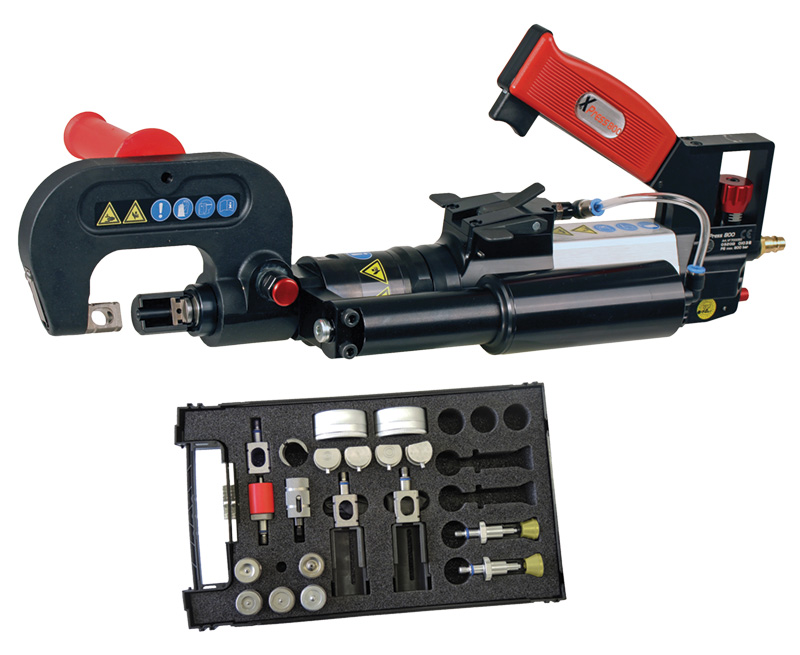
The Mercedes-Benz-approved XPress 800 modular system includes the XPress 800 Base Power Pack, PushPull pressure cylinder, C-arms, add-on modules, and setting and punching dies for installing and removing almost every type of rivet (image courtesy of Reliable Automotive Equipment).
Fortunately, new modular riveting tool systems are available that can remove and install either pop, SPR, or FFR — three popular types of rivets. The Xpress 800 from Wielander & Shill features different snap-in power unit and insertion or extraction modules that quickly adapt it to the specific rivet type and application.
Weld bonding
Weld bonding replaces welding with adhesive in some portions of a joint. The use of either spot welding or intermittent MIG/MAG welding separated by adhesive over long areas of the joint retains strength while reducing heat stress in thin or heat-sensitive substrates. By gluing the entire length and width of the mating surfaces between spot welds, weld bonding strengthens the joint. The adhesive adds corrosion protection, especially when it separates dissimilar metals. Last, weld bonding helps reduce the effects of vibration and cuts down on noise entering the passenger compartment.
Getting a grip
Mercedes-Benz will specify the correct rivet length, strength, and type of material for creating a strong joint.It will also recommend the best coating for sealing and corrosion resistance, and the adhesive that will offer the strongest protection against shear and peel failures. Everything you need to get a grip on the new adhesive, weld, and rivet bonding techniques is in your Mercedes-Benz service information.
Download PDF 〉





0 Comments